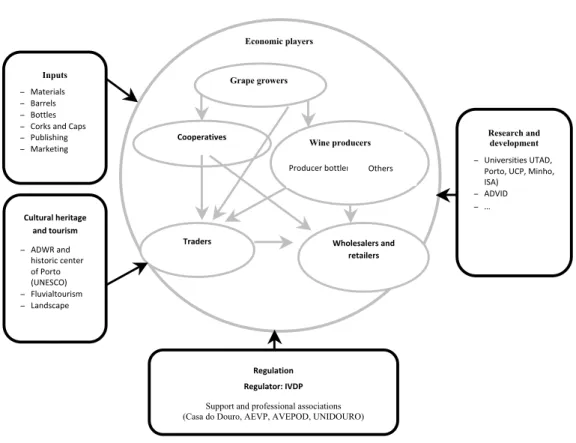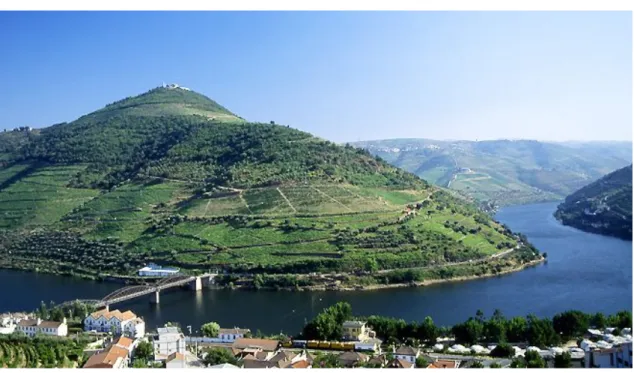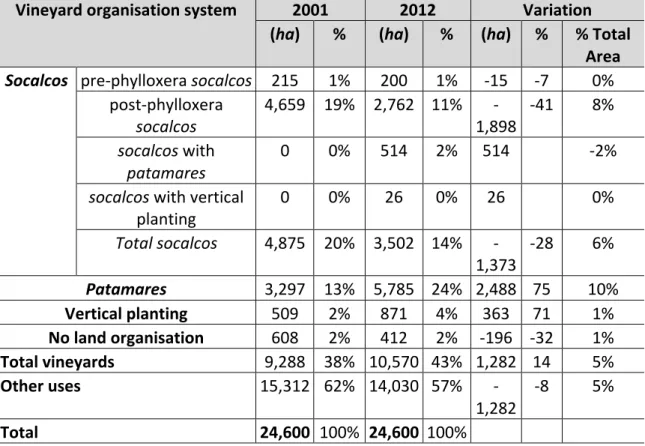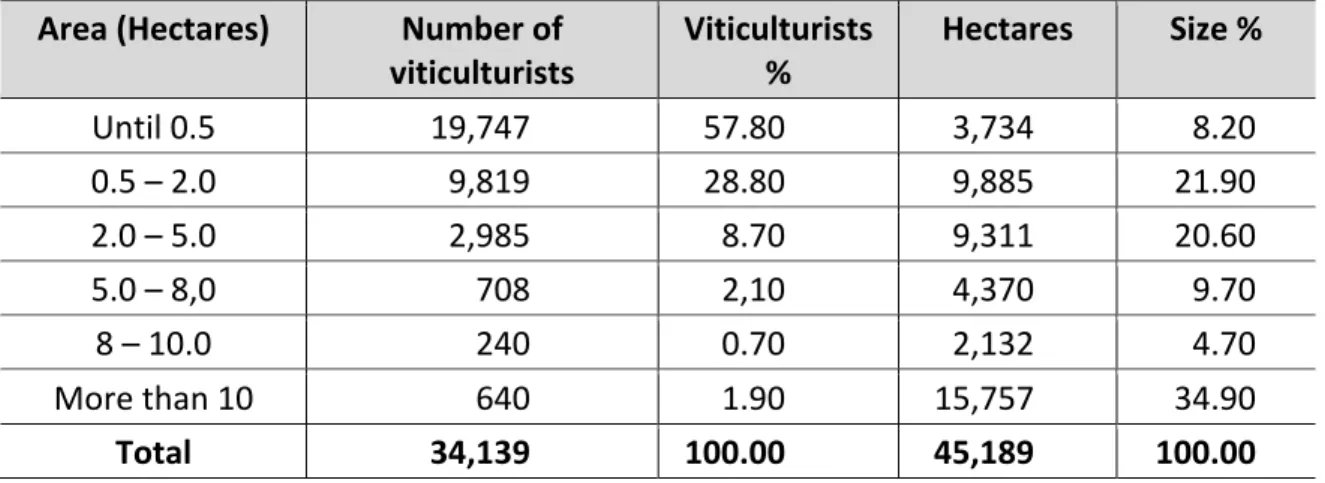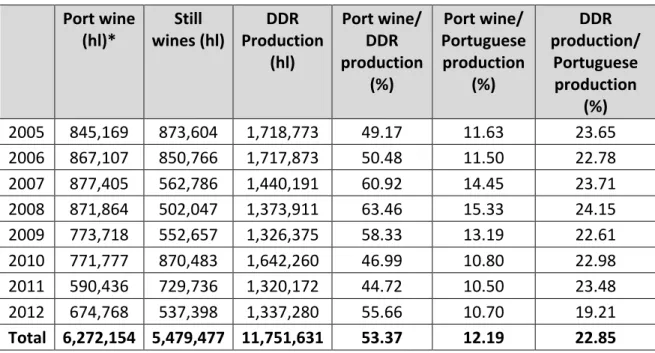ABSTRACT
The Demarcated Douro Region (DDR) dates from 1756, when it was recognized as one of the first demarcated regions in the world. The DDR economic activities fit the terroir model and are based on wine and tourism. Both activities have witnessed deep and structural changes along the last three decades, with influence in the current socio-‐ economic performance of the region. The objective of this paper is to present the recent evolution of the DDR wine filiere and tourism. The Port wine continues to be the star product of DDR, with almost 90% being exported. However, along the last decade the still wines evolved from being almost unknown to a position of a national and international recognition in market niches. The tourism in Douro region is connected to the wine filiere and tends to be structured under two dominant influences: the river and the terroir.
_________________________________________________________
Keywords: Wine Region, World Heritage, Wine and Tourism.
∗
E-‐mail address: jrebelo@utad.pt ‡E-‐mail address: jcaldas@utad.pt
† E-‐mail address: alexandreguedes@msn.com
AlmaTourism
Journal of Tourism, Culture and Territorial Development
___________________________________________________________
The Douro Region: Wine and Tourism
Rebelo J. ∗
Caldas, J. ‡
Guedes A. †
University of Trás-‐os-‐Montes and Alto Douro (Portugal)
Introduction
Both the wine and tourism industries have a strong regional and a rural basis and, sometimes, share locations, customers, suppliers and interconnected networks (Nunes and Loureiro, 2012). The growth of one sector may have positive impacts on the other. This convergence or overlap developed a hybrid wine-‐tourism industry, i.e., an industry which is emerging endogenously from the specific sectors of viticulture/wine making and tourism. The development of wine tourism has provided considerable economic growth regional opportunities. This phenomenon (Hall et al, 2000) has been recognized both in the old world wine and new world wine producing countries. Additionally, the classification of a site as a world heritage enhances this it as a tourist destination, with a positive impact on the local development as it happens in other sites with the same nomination (Cuccia et al., 2013 and Arezki et al., 2009).
In fact the wine is like a handcrafted and traditional product at the same time linked to creativity and innovation, a key element of intangible heritage and of social, cultural and so territorial identity , and increasingly important experience for the tourist practices and leisure. Handed down to us by past generations, wine represents a tradition especially of the Mediterranean region, where wine came through Greeks and Phoenicians and from Sicily spread like wildfire in the central -‐ northern Italian regions by Etruscan (1000 B.C.) With the Roman Empire viticulture spreads enormously: precisely the Romans started from the second century A.D. growing grapes in Europe and in places now famous and renowned wine Italian, French and Portuguese districts.
Archeological records sign the presence of vineyards in Douro, Portuguese region (Fig.1), since the Roman times. The emergence of the present Demarcated Douro Region (DDR) dates from 1756, when it was recognized as one of the first demarcated regions in the world, with a legislative framework similar to that currently applied in the most famous traditional wine regions (Fig.2). Viticulture is the economic base of the DDR covering an area of 45,000 ha, almost 18% of the total area of the region. In 2001, located in deep valleys and steep slopes along the Douro River and its tributaries, 24.600 ha of the DDR (Alto Douro Wine Region – ADWR) were included by UNESCO in the list of the World Heritage sites, as a cultural and evolving landscape were its communities has been producing wine for nearly two thousand years and its landscape has been moulded by human activities with winemaking – terraces, quintas (wine-‐ producing farm complexes), villages, chapels, and roads. This DDR is an example of a traditional European wine region and reflecting the evolution of the human activity over the time (Fig.3).
The main economic activities of DDR are again wine and tourism (Andresen and Rebelo, 2013). Both activities have witnessed deep and structural changes along the last three decades, with influence on the present socio-‐economic performance of the region.
Fig. 1 The Douro Map
Fig. 2 The Douro Valley: the Alto Douro Portugal
Source: Port Vineyards.
Fig. 3 The UNESCO Valley of Douro
Source: dourovalley.eu
The objective of this paper is to analyze the recent evolution of the: (a) Douro wine
filiere, taking special attention to the DDR wine cluster and to the structure of the vines
and the production and marketing of wines; (b) tourism phenomenon, particularly looking at the region as a tourist destination, examining the behavior of the supply and demand. To achieve this goal the paper includes a brief analysis of the Douro wine cluster, a discussion of the Douro wine filiere and tourism, concluding with some final remarks.
1. Douro Wine Filiere
a) The DDR wine cluster
Rebelo and Caldas (2013), taking into account the local, regional and international background of the wine industry, analyzed the DDR structure and behavior using a cluster approach (Fig. 4).
Fig. 4: DDR wine cluster
Source: Rebelo and Caldas (2013)
The authors (p.35) concluded that the DDR is a typical terroir model1 and fits the
organized cluster, as happens in other European wine regions (e.g. Bordeaux). This
conclusion is based on the analysis of the following structural variables: (a) Number of critical actors low and the firm size dominated by micro and SMEs. (b) There is some innovation (R&D), albeit not continuously, classified between low and high, that can be fostered through an increase in the level of trust. (c) The levels of skill and technology
Inputs
− Materials − Barrels − Bottles − Corks and Caps − Publishing − Marketing Cultural heritage and tourism − ADWR and historic center of Porto (UNESCO) − Fluvialtourism − Landscape Grape growers Cooperatives Wine producers
Producer bottlers Others
Traders Wholesalers and
retailers
Research and development
− Universities UTAD, Porto, UCP, Minho, ISA)
− ADVID − …
Regulation Regulator: IVDP
Support and professional associations (Casa do Douro, AEVP, AVEPOD, UNIDOURO)
are medium-‐high. (d) There are some links between the players of the cluster, but the knowledge transfer circuits can be improved and more extensive. (e) There is some cooperation between the players, some of it resulting from informal and formal networks among the economic players and other sustained and imposed by the regulatory entity; there is a strong competition between economic players, especially at the phase of distribution of the added value created along the chain. (f) During the last decades the still Appelation d´Origine Controlée (AOC) wines suffered important changes and the exports are considered medium-‐high.
Taking into account the diagnosis, and in order to improve the performance of the DDR wine cluster, additional policy measures are required, namely :
(a) to increase the size of firms and the number of critical actors, in order to allow producers to make heavy investments that enables them to react outside pressures; (b) to introduce and spread a real culture of continuous innovations in the different phases of the wine-‐chain, anticipating or provoking changes in world market demand; (c) to amplify the cooperation and the network between the different cluster players for a generalized and better diffusion of knowledge and skills.
b) Vines and wines
The wine is the economic base of the DDR, a region where the terroir characteristics are present, as clearly expressed by UNESCO, when classified this region as a world heritage site according to the following: Criterion (iii) -‐ The Alto Douro Region has been
producing wine for nearly two thousand years and its landscape has been molded by human activities; Criterion (iv) -‐ The components of the Alto Douro landscape are representative of the full range of activities associated with winemaking -‐ terraces, quintas (wine-‐producing farm complexes), villages, chapels, and roads; Criterion (v) -‐ The cultural landscape of the Alto Douro is an outstanding example of a traditional European wine-‐producing region, reflecting the evolution of this human activity over time.
According to the Centre for the Research, Study and Advancement of Mountain Viticulture (CERVIM), the DDR is the largest and most heterogeneous wine mountain region in the world, characterized by valleys strongly embedded by steep high slopes along the river Douro and its tributaries, dominated by shale and cold winters, hot summers and low rainfall. We are in the presence of hillside vineyard, being more than 40% of the vines installed in plots with a slope higher than 40% (Quaternaire Portugal / UCP, 2007), which makes mechanization very difficult and requiring manual labor, consequently, leading to high production costs (Fig. 5).
Fig.5 Cruises on the Douro River
Source: visitportugal.com
During the last thirty years an intense process of Douro vineyard conversion was carried out by grape growers with strong public support (Magalhães et al., 2013), renovating 21,940 ha, almost 49%, of the DDR under vine. This dynamic starts in 1980s with the stimulus given by the Integrated Rural Development Project of Trás-‐os-‐Montes (PDRITM) financed by the World Bank, resulting in the planting of 2,500 ha of new vineyards and the reconversion of 300 ha. This program introduced two new land terracing systems – wide patamares (terraces supported by earth banks) and vertical planting (Fig.6). Financed by funds from the European Union, the investments on reconversion of vineyards continued in the subsequent decades (4,400 ha in the 1990s and 14,740 ha in the last decade.
Table 1 presents the evolution of the land organization systems of vineyards2, between 2001 and 2012, in the ADWR area classified by UNESCO. In 2012, 55% (5,875 ha) of the vineyards are on patamares, with a rise of approximately 2,500 ha from 2001. This ascending curve was also noted in vertical planting (more 363 ha), although on a much lower scale. The class that experienced the greatest contraction (1,900 ha) was vineyards on post-‐phylloxera socalcos. However, in 2012, two new typologies for land organisation were registered: socalcos with patamares and socalcos with vertical planting, respectively with 514 ha and 26 ha. The new forms of land organisation seek to reconcile heritage conservation with mechanised crop operations using new technologies (Magalhães et al., 2013).
Table 1: Evolution of the land organisation systems of vineyards between 2001 and 2012
Vineyard organisation system 2001 2012 Variation
(ha) % (ha) % (ha) % % Total Area
Socalcos pre-‐phylloxera socalcos 215 1% 200 1% -‐15 -‐7 0% post-‐phylloxera
socalcos 4,659 19% 2,762 11% 1,898 -‐ -‐41 8%
socalcos with
patamares 0 0% 514 2% 514 -‐2% socalcos with vertical
planting 0 0% 26 0% 26 0%
Total socalcos 4,875 20% 3,502 14% -‐
1,373 -‐28 6%
Patamares 3,297 13% 5,785 24% 2,488 75 10%
Vertical planting 509 2% 871 4% 363 71 1%
No land organisation 608 2% 412 2% -‐196 -‐32 1%
Total vineyards 9,288 38% 10,570 43% 1,282 14 5%
Other uses 15,312 62% 14,030 57% -‐
1,282 -‐8 5%
Total 24,600 100% 24,600 100%
Source: Magalhães et al. (2013: A1-‐23).
Source:agoodnose.com
Similarly to the oldest wine regions of Europe, the property structure in DDR is skewed (Table 2), with 45,189 ha of vineyards distributed amongst 34,139 grape-‐growers, an average farm size of 1.32 ha. Compared with 2006 (Quaternaire Portugal/UCP, 2007), the total area of vineyards remain relatively unchanged but the number of viticulturists decreased by 14%, a trend that will continue in the near future, since we are in the presence of an aging population (Rebelo et al., 2013).
Roughly 35% of the DDR area is owned by just 640 grape-‐growers. The average farm size for this group is around 27.70 ha, an increase of 41% compared with 2006. Most of these farms belong to bottler-‐wine-‐producers and traders of Port wine. In contrast, small and medium size grape-‐growers are mostly members of wine cooperatives (Rebelo et al., 2010).
Table 2: Number of Grape Growers and Farm Size in the DDR, in 2012 Area (Hectares) Number of
viticulturists Viticulturists % Hectares Size %
Until 0.5 19,747 57.80 3,734 8.20 0.5 – 2.0 9,819 28.80 9,885 21.90 2.0 – 5.0 2,985 8.70 9,311 20.60 5.0 – 8,0 708 2,10 4,370 9.70 8 – 10.0 240 0.70 2,132 4.70 More than 10 640 1.90 15,757 34.90 Total 34,139 100.00 45,189 100.00
Source: IVDP (www.ivdp.pt)
Two categories of wines are produced: Porto wine and still wines. Table 3 includes the wine production in most recent years. The DDR annual average production is 1,468,954 hl (an average of 32.51 hl/ha), around 23% of the Portuguese wine production3. Port wine represents 53% of the DDR production and 12% of the domestic production. Port wine and still wines have different market positions. The Port wine has a story of more than two centuries of being exported, albeit cyclical movements. Recent data (Table 4) shows that Port wine is witnessing a negative phase, expressed by a 12% sales decrease in volume and 11% in value, between 2005 and 2012. The domestic demand remained relatively stable, around 13-‐14%, in quantity and 15-‐16% in value. Unquestionably, it is a globalized product, sold around the world, although the main market is the EU followed by USA and Canada (www.ivdp.pt).
Table 3: DDR production: 2005-‐2012 Port wine
(hl)* wines (hl) Still Production DDR (hl) Port wine/ DDR production (%) Port wine/ Portuguese production (%) DDR production/ Portuguese production (%) 2005 845,169 873,604 1,718,773 49.17 11.63 23.65 2006 867,107 850,766 1,717,873 50.48 11.50 22.78 2007 877,405 562,786 1,440,191 60.92 14.45 23.71 2008 871,864 502,047 1,373,911 63.46 15.33 24.15 2009 773,718 552,657 1,326,375 58.33 13.19 22.61 2010 771,777 870,483 1,642,260 46.99 10.80 22.98 2011 590,436 729,736 1,320,172 44.72 10.50 23.48 2012 674,768 537,398 1,337,280 55.66 10.70 19.21 Total 6,272,154 5,479,477 11,751,631 53.37 12.19 22.85 Source: Authors’ computations from data collected in Instituto de Vinho do Douro e Porto -‐ IVDP (www.ivdp.pt) and Instituto da Vinha e do Vinho -‐ IVV (www.ivv.min-‐agricultura.pt)
Table 4: Sales of Port wine: 2005 -‐ 2012
2005 2006 2007 2008 2009 2010 2011 2012 Domestic market − Volume (hl) − Value (103 euro) − Euro/litre 129,33 0 63,029 4.87 130,86 0 64,224 4.91 128,43 0 61,704 4.80 125,10 0 59,578 4.76 110,16 0 51,874 4.71 120,90 6 55,327 4.58 106,60 7 50,321 4.72 110,33 9 52,104 4.72 Exportatio ns − Volume (hl) − Value (103 euro) − Euro/litre 807,75 0 341,93 0 4.23 785,25 0 331,68 5 4.22 814,05 0 342,55 0 4.21 767,07 0 316,22 2 4.12 725,94 0 300,26 6 4.14 741,60 4 315,47 4 4.25 718,62 4 305,59 2 4.25 715,27 3 308,28 2 4.31 Total − Volume (hl) − Value (103 euro) − Euro/litre 937,08 0 404,95 9 4.32 916,11 0 395,90 9 4.32 942,48 0 404,25 4 4.29 892,17 0 375.80 0 4.21 836,10 0 352,10 0 4.21 862,51 1 370,80 1 4.30 825,23 0 355.91 2 4.31 825,61 2 360,38 6 4.37
Source: IVDP (www.ivdp.pt)
Regarding still wines, only a part of the total production is sold as AOC wines (Table 5). Between 2005 and 2012 the share of AOC in still wines increased, reaching a maximum (71%) in 2008. In 2012, the exports of AOC wines represented around 40.7%, in volume, and 41% in value, with an average price per liter of 3.89 euro in the domestic market and 3.95 euro in external markets, averaging 3.91 euro. Comparing with 2005, these prices increase 73%, 16% and 60%, respectively. In the same period the domestic market decreased 41% and the exports increased 89%, showing that the Douro wine firms are searching for new external markets.
It is important to highlight that is only with Portugal’s entry into the European Union (1986) that the grape-‐growers started to develop their own labels and bottle their wines rather than selling the grapes to Port wine shippers, as they did for nearly two centuries. These new start-‐ups produced predominately red still wines. While these new brands found heavy demand in Portugal, their entrance in the international markets became quite difficult, since Douro wine region was not known at all, and therefore did not represent a category to be included in the wine lists and shelves (Rebelo and Muhr, 2012).
Table 5: Sales of DDR´s AOC wines
2005 2006 2007 2008 2009 2010 2011 2012 Domestic market − Volume (hl) − Value (103 euro) − Euro/liter 230,4 81 51,86 6 2.25 268,9 56 62,37 4 2.32 308,5 20 70,07 0 2.27 279,3 69 70,64 5 2.53 222,4 53 66,15 6 2.97 142,4 00 56,11 3 3.94 136,3 17 52,07 6 3.82 136,2 83 52,95 3 3.89 Exportations − Volume (hl) − -‐ Value (103 euro) − -‐ Euro/liter 49,54 5 16,85 3 3.40 58,14 0 20,71 7 3.56 69,82 2 25,24 3 3.61 74,64 6 26,97 7 3.61 77,20 2 27,68 0 3.59 71,16 2 29,08 7 4.09 85,57 1 34,00 0 3.97 93,39 6 36,87 8 3.95 Total − Volume (hl) − Value (103 euro) − Euro/liter 280,0 26 68,71 9 2.45 327,0 96 83,09 1 2.54 378,3 42 95,31 3 2.52 354,0 15 97,62 2 2.76 299,6 55 93,83 6 3.13 213,5 62 85,20 0 3.99 221,8 88 86,07 6 3.88 229,6 80 89,83 1 3.91 Sales of still
wines/Product ion of year
0.32 0.38 0.67 0.71 0.54 0.25 0.30 0.43
The market strategy followed by these new wine producers has been based on differentiation for niche markets, where production is made through marketing events, press releases and interactions with wine experts (such as media, trade and gastronomy) in the target markets. One of the consequences of this entrepreneurial behavior is the emergence, in the last decade, of Douro still wines which, from being unknown, have achieved, within a decade, a high national and international recognition (Rebelo and Muhr, 2012). For instance (Caldas and Rebelo, 2013), in 2010, the rater Robert Parker ranks 26 Portuguese wines (23 red and 3 white wines) above 90, of which 23 (21 red and 2 white wines) are from Douro region. In the same year, Wine Spectator awards scores above 90 points to 27 wines, all red and from Douro. Cellartracks4 rates 23 wines above 90 points, all red and 22 from Douro.
2. Tourism
Since the registration of ADWR as world heritage the tourism in the Douro has enjoyed strong political and institutional support by the Portuguese government (Andresen and Rebelo, 2013), highlighting the importance of the region as touristic destination. The unique characteristics of the region were emphasized by the National Geographic Society that, in 2010, ranked the Douro in 7th place, among 133 sites/destinations, in the category of Best Rated Places, taking into account its environmental and ecological quality, social and cultural integrity, level of preservation of the historical buildings and archeological sites and the tendency to remain so.
The tourism in the Douro region tends to be structured under two dominant influences, the river (Douro) and the terroir. Relatively to the Douro River, its navigability started in 1994, showing nowadays a remarkable economic vitality (table 6). In 2013, 35 companies were operating with 86 regular boats and 11 hotel boats with a total occupancy of 6,124 passengers. The water-‐born sector, however, holds two subsectors that exhibit divergent behaviors, the hotel boats (cruising ships) showing an occupancy rate of roughly 76 %, and the regular boats a rate lower than 50%, between 2010 and 2013.
Table 6: River tourism supply indicators: 2010 -‐ 2013
Supply 2010 2011 2012 2013
Companies operating regular boats -‐ 32 34 35
Number of regular boats 51 54 66 86
Number of hotel boats 7 8 8 11
Total boats occupancy 4,810 5,519 5,874 6,124
Hotel boats occupancy rate 76.45% 75.19% 76.75% 76.75%
Regular boats occupancy rate 52.20% 45.24% 42.01% 42.01%
Source: IPTM (2013)
Overall the water-‐born sector has been growing consistently (Table 7), with an average growth rate of 21 % between 2007 and 2013, having carried in the last year a total of 545,630 passengers. From these 39,352 (7.2 %) traveled in hotel boats, 150,034 (27.5 %) in 1-‐day cruises, 5,969 (1.1%) in recreation boats and 350,275 (64.2%) in small trip cruises in the same reservoir.
Table 7: Number of passengers per type of boat/trip: 2007 – 2013
Demand 2007 2008 2009 2010 2011 2012 2013 Average Var. 2007/201 3 Hotel boats (BH) 17,724 20,982 19,711 22,017 26,454 28,089 39,352 15.08% Cruises – 1 day (C) 148,016 144,187 159,198 173,143 153,033 135,688 150,034 0.70% Recreation boats (R) 6,820 4,842 6,457 6,160 5,724 5,632 5,969 -‐0.50% Cruises in the same reservoir (CMA) -‐ -‐ -‐ -‐ -‐ 243,41 9 350,275 43.90% Total (BH+C+R+CM A) 172,56 0 170,011 185,366 201,320 185,211 412,831 545,630 27.20% Source: Source: IPTM (2013)
On the demand side there are sharp differences on the type of users, according to the category of boat/trip. Roughly 97% of the hotel boat (cruise ships) market is concentrated within an international frame in opposition to 1 day cruises which depend most entirely on the domestic market, around 94% of its total demand (IPTM, 2013). The hotel boat market is mainly centered on international big cruising companies (e.g. Croisieurope and Viking). Most of the tourists come from European countries, almost 77% of total demand (France, 22%; United Kingdom, 15%, Germany, 14% and others 26%), and of the United States of America which generates around 22 % (IPTM, 2013).
The touristic activities within the terroir are well embedded in the cultural environment of this region which is clearly based on the wine filiere. During the 1990s, the evolution of the traditional quinta (wine producing properties) to satisfy the new agro-‐tourism demand is an important landmark that shows the linkage between wine and tourism. Altogether, there are presently 25 quintas that fulfill tourism requirements (Rebelo et al, 2013).
Moreover, in 2012, the lodging sector combines 36 hotels, fulfilling a capacity of 2,303 beds (Table 8), with a considerably higher number of rural tourism units (101), although with a smaller number of beds (552).which is equivalent to a ratio of 5 beds
per unit versus 64 beds per hotel. On average, between 2010 and 2012 the hotel establishments were responsible for a guest room income of almost 8 million euro.
Table 8: Hotel establishments and rural tourism units: 2010 – 2012
Supply 2010 2011 2012 Ratio
Beds/Units
Number of hotel
establishments 34 39 36
Number of beds in hotel
establishments 2,280 2,466 2,303 64
Number of rural tourism units
(TER) -‐ -‐ 101
Number of beds in rural
tourism units -‐ -‐ 552 5
Guest room income -‐ hotel
establishments 8,334,000€ 8,466,806€ 7,098,000€
Source: INE/ERTD (2012)
Despite the classification of ADWR in 2001 as world heritage, the number of hotels and beds did not increase, meaning that the results achieved are below what was anticipated after its UNESCO nomination. The number hotels/beds in 2001 were 34/2,276 and in 2012 36/2,303 (INE, 2001-‐2012).
Relatively to the demand of hotels, the overnights and number of guests (table 9) show a decrease, between 2001 and 2012, of -‐1.6% and -‐1.1%, on average, respectively. The average stay has remained on the threshold of 1.5 nights and the net occupancy rate of 28% in 2001 and 23.7% in 2012, suggesting that the Douro hotel tourism still has a long way to run in order to achieve reasonable economic results.
Table 9: Tourism demand trends – hotel establishments: 2001 – 2012
Demand 2001 2002 2003 2004 2005 2006 2007 2008 2009 2010 2011 2012 Mean 2001/2023 Overnights at hotels (1) 233,464 234,877 221,220 233,255 224,428 221,081 228,181 217,074 215,248 223,416 220,116 192,463 -‐1.6% Number of guests in hotels (2) 145,402 154,874 146,851 153,721 151,607 151,181 157,655 140,879 129,787 136,567 142,488 125,414 -‐1.1% Nights spent 1.61 1.52 1.51 1.50 1.50 1.50 1.40 1.54 1.66 1.60 1.50 1.50 1.53 Net occupancy rate 28.00% 27.80% 25.60% 27.50% 26.50% 26.10% 26.60% 25.00% 25.60% 26.70% 25.40% 23.70% 26,21% Source: INE (2002-‐2013)
In opposition to boat hotels, the hotel demand is essentially concentrated in the domestic market, which represents on average, between 2001 and 2012, 78.55 % of total demand (INE, 2001-‐2012) with the remaining mainly dispersed by 6 European countries (United Kingdom, Spain, France, Germany, Netherlands and Italy).
Summing up from the demand side we can conclude that ADWR is not a massive touristic site, and will not be even in a near future. But it is expected that a significant increase will occur essentially in the boat hotel segment.
3. Conclusion
The Douro region is a typical terroir model that fits an organized cluster, similar to other famous traditional wine regions, whose main economic activities are wine and tourism. During the last 30 years DDR witnessed an intense process of vineyard conversion, 21,940 ha, almost 50% of the area under vine. Two categories of wines are produced, Porto and still wines. The former has a history of more than two centuries of being exported (86% of the total sales), although, in the last decade, have witnessed a negative trend. Regarding still wines, their entrance in the market is recent. Only after Portugal joined the European Union the grape-‐growers started to vinify and bottle their wines. In 2012, the exports of AOC wine represented 40.7% in volume and 41% in value. Moreover in the last decade the Douro wines evolved from being almost unknown to a position of a national and international recognition in market niches. This evolution was led by high qualified start-‐ups, with a market strategy based on quality in which the terroir Douro region is a key competitive component.
The tourism in Douro region is connected to the wine filiere and tends to be structured under two dominant influences: the river and the terroir. The first comprises a wide array of nautical tourism activities, where the hotel boat subsector seems to excel, maintaining a level of sustainable growth based on its distribution system which is bonded to an extensive range of international markets. The terroir which also convenes a broad assortment of wine tourism activities (quintas and hotels) seems to be very much dependent on the domestic market. Although these two fields are in some cases functionally connected, they display dissimilar and distinct demand volumes and trends which confirm the need to strengthen and deepen their relationship. If on one hand the hotel boats subsector appears to embody an important gateway for the wine tourism economy to achieve a relevant level of internationalization, it seems however to be lacking a level of convergence with the tourism terroir resources and activities.
References
Andresen, T. and J. Rebelo (2013). Assessment of the State of Conservation of the
Property Alto Douro Wine Region – Evolutive and Living Cultural Landscape – Assessment Report. Porto: CCDRN/EMD, CIBIO UP-‐UTAD.
Arezki R., R. Cherif and J. Piotrowski (2009). Tourism Specialization and Economic Development: Evidence from the UNESCO World Heritage List. International Monetary
Fund – Institute and Fiscal Affairs Department, IMF working paper AP/09/176.
Cuccia, T., C. Guccio ad I. Rizzo (2013). Does UNESCO Inscription Affect the Performance
of Tourism Destinations? A Regional Perspective. Association for Cultural Economics
International. ACEI working paper series AWP-‐04-‐2013.
Ditter, J. G. (2005). Reforming the French Wine Industry : Could Clusters Work? Cahiers
du Ceren, 13 : 39-‐54.
ERTD (2012), Guia Turístico do Douro, Vila Real, Portugal.
Hall, M.C., M. Sharples, B, Cambourne, N. Macionis; R. Titchell and G. Johnson (Eds), (2000). Wine Tourism Around the World: Development Management and Markets. Oxford: Butterworth-‐ ´Heinemann.
INE – Instituto Nacional de Estatística (2002-‐2013), Anuário Estatístico da Região Norte: 2001-‐2012, Portugal.
IPTM – Instituto Portuário e dos Transportes Marítimos (2013). Estatística Via
Navegável do Douro (VND). Retrieved May 13, 2013, from
http://www.douro.iptm.pt/_admin/upload/estatisticas/7/8044952_file01.pdf.
Magalhães N., Magalhães M., Sousa V. (2013). A1 – Alterações ao Uso do Solo, in Avaliação do Estado de Conservação do Bem Alto Douro Vinhateiro – Paisagem Cultural Evolutiva Viva, Volume 2 – Estudos de Base. Porto: CIBIO UP/UTAD: A1.01-‐A1.31.
Nunes, P. and M. Loureiro (2012). Agricultural Landscape, Vineyards and Tourism Flows
in Tuscany, Italy: Results from an Applied Economic Study. American Association of
Wine Economists, AAWE working paper No. 103 Economics www.wine-‐economics.org.
Quaternaire Portugal/UCP (2007). Plano Estratégico para os Vinhos com Denominação
de Origem Controlada Douro, Denominação de Origem Porto e Indicação Geográfica Terras Durienses da Região Demarcada do Douro. IVDP, Porto, Portugal.
Rastoin, J.L. and V. Vissac-‐Charles (1999). Le Group Stratégique des Enterprises de Terroir. Revue Internationale PME, vol. (12): 171-‐192.
Rebelo, J., A. Guedes, L. Lourenço-‐Gomes, M. T. Sequeira (2013). Balanço de
Concretização do Programa de Ação, in Avaliação do Estado de Conservação do Bem
Alto Douro Vinhateiro – Paisagem Cultural Evolutiva Viva, Volume 2 – Estudos de Base. Porto: CIBIO UP/UTAD: B.3-‐01-‐B.3-‐74.
Rebelo, J. and D. Muhr (2012). Innovation in wine SMEs: The Douro Boys informal network. Studies in Agricultural Economics, 114: 111-‐117.
Rebelo, J. and J. Caldas (2013). The Douro Wine Region: a cluster approach. Journal of
Wine Research, March 2013, vol. 24 (1): 19-‐37.
1 Terroir is defined as a clearly identified and homogeneous territory endowed with a strong identity which is
characterized by the whole of natural and cultural resources (Rastoin and Vissac-‐Charles, 1999), generally backed up by a certificate of guaranteed origin label (Ditter, 2005).
2 For the remaining DDR area this information was not available. The assessment of the classified site requires a
detailed analysis of the landscape evolution, including plantation systems (Andresen and Rebelo, 2013).
3 According IVV (www.ivv.pt), the total domestic vineyard area is 237,786 ha, representing the DDR 19%. 4 Is a website (http://cellartracks.com) in which consumers express their opinion and ascribe their scores.

